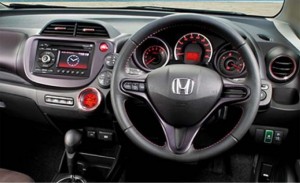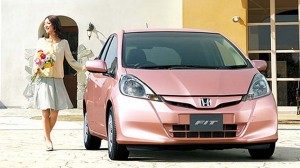The auto industry has traditionally been male-dominated but Honda has rolled out a new model it claims to have specifically designed with women in mind.
The new Honda Fit She’s is a pretty-in-pink version of the maker’s familiar subcompact that offers a few niceties the maker believes will specifically appeal to distaff buyers, such as a windshield designed to block skin-wrinkling ultraviolet rays.
But will women actually care? While the new Honda subcompact may be the only car currently on the road specifically targeting women there’s a good reason. Previous feminine offerings, such as the old Dodge LaFemme, met with little more than indifference and, in some cases, outright hostility.

Pretty in pink -- the Honda Fit She's also offers touches like a UV-resistant windshield to reduce wrinkles.
Priced at $17,500 – at current exchange rates – the Honda Fit She’s is currently available only in the Japanese market and it’s unclear whether the maker will roll it out in other parts of the world.
Like those vehicles handed out as prizes by Mary Kay Cosmetics, the dominant shade is pink, starting with the exterior pain and including the interior pink stitching and tutti-frutti-hued chrome bezels. If that doesn’t get the message across, Honda uses a pretty little heart to replace the apostrophe in “She’s.”
To Honda’s credit, the maker also has plans to offer the special model in an alternate hue that might best be called “eyeliner brown.”
The Fit She’s also delivers some other features women might appreciate. That includes the special UV-blocking window glass. Recent studies have underscored concerns that extended exposure to the sun while driving can be nearly as bad for the skin as spending too much time on the beach.
The Honda Fit She’s also features a “Plasmacluster” climate control system the maker claims can improve skin quality.
The decision to offer the car in the Japanese market isn’t all that much of a surprise considering the country’s more traditional sex-defined roles. As much as half of all Japanese women stay out of the workforce and still more tend to shift to homemakers after getting married. But even for those women who do join the workforce, there is more of a divide in tastes than one might find in Western countries.
That has stifled efforts by European and U.S. manufacturers who previously tried to target products directly to women. Chrysler, for one, thought it had a winner with the 1955 LaFemme. The sedan featured special storage places for hat and purse – and the driver’s seat swiveled to allow a woman wearing a skirt to enter or exit the vehicle with appropriate modesty. Nonetheless, like the few other offerings openly aimed at American women over the years, LaFemme proved LaFlop.
One might think that the U.S. auto industry would be inspired by the Honda Fit She’s. After all, women now directly purchase over a third of the vehicles sold in the States, while data from J.D. Power and Associates suggests they “influence” as much as 60% of all vehicle purchases.
Yet, just the hint of being a “woman’s car” can prove the kiss of death. Despite their tremendous flexibility and functionality, minivans lost much of their cache, noted Nissan marketing executive Tom Smith, when they become known as “soccer-mom vehicles.” Chrysler tried to counter that image when it released its latest version of the Dodge Durango by dubbing it the “man van,” but with little success.
Volkswagen blames the fall off in sales of the so-called “New Beetle” to the fact that the vehicle became known as a “chick car.” Jonathon Browning, head of Volkswagen Group of America, says the maker specifically wanted to make the latest version of the Beetle, introduced a year ago, “look more masculine.”
That doesn’t mean makers are ignoring the needs of women. Both Ford and General Motors, among many makers, have established groups of women designers and engineers who specifically consider the features and attributes of new products looking for ways to appeal to feminine needs – and avoid problems that might not be apparent to their male colleagues.
That might include door handles that can snap off long fingernails. And a number of new vehicles now feature larger center storage bins able to handle a pocketbook – while men get the added benefit of being able to tuck away their iPads and other electronic goodies.
Some makers have also introduced new colors that they believe will have bigger appeal to women buyers – though whatever their sex, studies by paint suppliers like DuPont Automotive show that silver, black and white continue to dominate.
So, while automakers clearly want to win over women shoppers, few are likely to follow Honda’s lead, especially outside of Japan. In most of the rest of the world, women car buyers just wanted to be treated as one of the guys.

